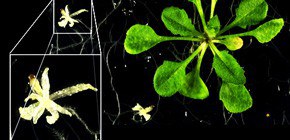
Protein Traffic in Plant Cells: Chloroplast Protein Translocon Revealed
Osaka University biologists discover a genuine protein translocation machinery at the chloroplast inner envelope membrane, which surprisingly contains a subunit encoded by a previously enigmatic long open reading frame in the chloroplast genome.
Virtually all life forms on earth depend on organic materials produced by photosynthesis, either directly or indirectly. Plants and algae, the eukaryotes, and photosynthetic bacteria including cyanobacteria, the prokaryotes, perform this important reaction. In plants and algae, photosynthesis is carried out in specialized organelles called chloroplasts.
Almost all chloroplasts in today's photosynthetic eukaryotes derive from one primary endosymbiotic event with a cyanobacterium-like ancestor thought to have occurred more than a billion years ago. This was followed by massive transfer of genes from the endosymbiont to the host's nuclear genome, accompanied with the evolution of protein transport system that allows these nuclear-encoded proteins back into the endosymbiont.
Today's chloroplasts must import more than 2000 different nuclear-encoded proteins synthesized outside the chloroplast, across the double envelope membranes surrounding this organelle, to fulfill their complex physiological roles.
Researchers in Osaka University's Institute for Protein Research identified and characterized the previously controversial protein transport machinery, translocon, at the inner envelope membrane of chloroplasts from Arabidopsis thaliana. Their paper is due to be published in the journal Science , on Friday, February 1.
Dr. Masato Nakai , an associate professor of the Institute for Protein Research, has led the project since its inception in 1998.
He said, "While many proteins had been reported to be involved in preprotein translocation across the chloroplast inner envelope membrane, the identity of the translocon, termed TIC, had long been a matter of debate."
"Previously we identified a central component of TIC, and, in this study, using transgenic Arabidopsis plants expressing a tagged-form of the central component, we succeeded in purifying the entire translocon of approximately 1-megadalton in size as an intact complex."
In collaboration with a research group from Graduate School for the Creation of New Photonics Industries from Hamamatsu in Japan, they showed that the purified complex forms membrane channels in the lipid bilayers, where chloroplast preproteins specifically interact with the channel pore.
"The most compelling evidence for the direct involvement of this 1-megadalton complex as a general protein translocation machinery at the inner envelope membrane is," said Masato Nakai, "all the components of this 1-megadalton TIC complex were indeed found stoichiometrically associated with different translocating preproteins, and, more importantly, together with well-established components of the TOC protein translocation machinery at the chloroplast outer envelope membrane."
"Most excitingly, however," he continued, "one of the TIC complex components is encoded by a previously enigmatic long open reading frame ycf1 in the chloroplast genome." Notable is the fact that, while encoded in the chloroplast genome, the gene appears not to be of cyanobacterial origin but likely evolved after the primary endosymbiotic event, uniquely and unusually in the chloroplast genome but not in the nuclear genome.
"During evolution, the translocon at the chloroplast inner envelope has changed dramatically through modifications of both the nuclear and chloroplast genomes," said Masato Nakai. "The complete TIC complex seems to have been established when land plants evolved. Interestingly," he continued, "it has been still continuously changed! Because, based on the available completed genome information, recently diverged unique class of monocots formed by the grasses appears to have a bit distinct type of TIC complex."
"Why did the gene for this large component have to be added to the chloroplast genome? Where did it derive from? What are functions of other later-acquired nuclear-encoded subunits? And, why did the grasses need to evolve a different type of translocon? To address these interesting evolutionary conundrums, we have already started to investigate TIC complexes in early lineages of photosynthetic eukaryotes such as red algae and green algae, as well as in some grasses."
Citation: Shingo Kikuchi1, Jocelyn Bédard1, Minako Hirano2, Yoshino Hirabayashi1, Maya Oishi1, Midori Imai1, Mai Takase1, Toru Ide2, Masato Nakai1 (2013) Uncovering the Protein Translocon at the Chloroplast Inner Envelope Membrane. Science, in press, 1 February issue.
(1Institute for Protein Research, Osaka University, Japan; 2The Graduate School for the Creation of New Photonics Industries, Japan.)
CONTACT:
Dr. Masato Nakai
Institute for Protein Research, Osaka University, JAPAN
Tel: +81-6-6879-8612
Email: nakai@protein.osaka-u.ac.jp

Figure 1

Figure 2

Figure 3: This shows 2-weeks-old seedlings of Arabidopsis thaliana: a wild-type seedling with well-expanded green rosette leaves (right); semi-transparent albino seedlings of a mutant deficient in the identified TIC protein translocon at the chloroplast inner envelope membrane (left; inset, close-up view). The mutant lacks virtually all photosynthetic proteins and exhibits seedling-lethality. The mutant can survive until this developmental stage but only on sucrose-containing media.
To learn more about this research, please read the full research report entitled " Uncovering the Protein Translocon at the Chloroplast Inner Envelope Membrane " at this page of the Science website.
Related links :
